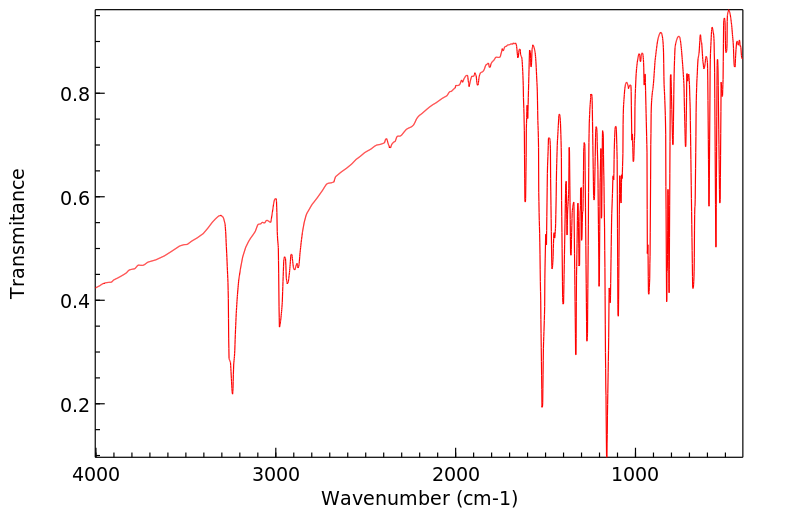Aniline, N,N-diethyl-p-(p-tolylsulfonamido)- | 19770-76-4
中文名称
——
中文别名
——
英文名称
Aniline, N,N-diethyl-p-(p-tolylsulfonamido)-
英文别名
N-[4-(diethylamino)phenyl]-4-methylbenzenesulfonamide
CAS
19770-76-4
化学式
C17H22N2O2S
mdl
MFCD01071213
分子量
318.44
InChiKey
ONDXXZIDUKAMOL-UHFFFAOYSA-N
BEILSTEIN
——
EINECS
——
-
物化性质
-
计算性质
-
ADMET
-
安全信息
-
SDS
-
制备方法与用途
-
上下游信息
-
文献信息
-
表征谱图
-
同类化合物
-
相关功能分类
-
相关结构分类
物化性质
-
熔点:154-156 °C (decomp)
-
沸点:469.8±55.0 °C(Predicted)
-
密度:1?+-.0.06 g/cm3(Predicted)
计算性质
-
辛醇/水分配系数(LogP):3.6
-
重原子数:22
-
可旋转键数:6
-
环数:2.0
-
sp3杂化的碳原子比例:0.29
-
拓扑面积:57.8
-
氢给体数:1
-
氢受体数:4
反应信息
-
作为反应物:描述:Aniline, N,N-diethyl-p-(p-tolylsulfonamido)- 以 aq. phosphate buffer 为溶剂, 生成参考文献:名称:一些二胺衍生物的热力学和电化学氧化:实验和理论研究摘要:Electrochemical oxidation of some diamine derivatives (1H(+)-411(+)) has been investigated both experimentally and theoretically. Experimental results were obtained using cyclic voltammetry and controlled potential coulometry and the theoretical results were calculated at DFT (B3LYP and BP86) levels of theory and 6-311+G (p,d) basis set. The calculated result indicates that oxidation potential of 1H(+)-4H(+) is directly dependent on the Delta G(tot) and species with more positive oxidation potential (E-pA1) have larger Delta G(tot), values. Also in this paper electrochemical oxidations of N,N-diethyl-p-phenylenediamine (3) were studied in the absence and in the presence of some nucleophiles. Mechanistic study of the electrochemical oxidation of 3 indicates that its electrochemical oxidation proceed in the thermodynamically favored direction. (C) 2015 The Electrochemical Society. All rights reserved.DOI:10.1149/2.0351512jes
-
作为产物:描述:对甲苯亚磺酸 、 N,N-二乙基对苯二胺 在 potassium hexacyanoferrate(III) 作用下, 以92%的产率得到Aniline, N,N-diethyl-p-(p-tolylsulfonamido)-参考文献:名称:N,N-二烷基-对苯二胺和芳基亚磺酸的化学和电化学氧化偶联。磺酰胺衍生物的合成摘要:在芳基亚磺酸作为亲核试剂的水溶液中,已经研究了N,N-二烷基-对苯二胺的电化学氧化和化学氧化,以合成磺酰胺衍生物。结果表明,电化学或化学生成的醌-二亚胺参与了与芳基亚磺酸的迈克尔型加成反应,并被转化为相应的磺酰胺衍生物。DOI:10.1016/j.tetlet.2010.10.014
文献信息
-
Utilization of transition metal fluoride-based solid support catalysts for the synthesis of sulfonamides: carbonic anhydrase inhibitory activity and <i>in silico</i> study作者:Deedar Ali、Sayyeda Tayyeba Amjad、Zainab Shafique、Muhammad Moazzam Naseer、Mariya al-Rashida、Tayyaba Allamgir Sindhu、Shafia Iftikhar、Muhammad Raza Shah、Abdul Hameed、Jamshed IqbalDOI:10.1039/d1ra07844e日期:——The applications of solid support catalysts in catalyzing organic reactions are well-evident. In the present study, we explored a transition metal fluoride (FeF3) adsorbed on molecular sieves (4 Å) as a solid support catalyst for the preparation of sulfonamides 3a–3o. The solid support catalyst was characterized via X-ray diffraction and AFM analysis. The catalyst was further explored for the synthesis固体载体催化剂在催化有机反应中的应用是显而易见的。在本研究中,我们探索了一种吸附在分子筛(4 Å)上的过渡金属氟化物(FeF 3 )作为制备磺胺类药物3a-3o的固体载体催化剂。通过X 射线衍射和 AFM 分析对固体载体催化剂进行了表征。进一步探索了该催化剂用于合成吲哚6a-h、1H-四唑和 1,4-二氢吡啶。研究了本文制备的磺胺类药物抑制碳酸酐酶(hCA II、hCA IX 和 hCA XII)的潜力。发现所有化合物都是具有 IC 50的活性抑制剂在低微摩尔范围内的值。有些化合物甚至被发现是高度选择性的抑制剂。化合物3i仅抑制 hCA II (IC 50 = 2.76 ± 1.1 μM) 并且对 hCA IX 和 hCA XII 具有 <27% 的抑制作用。类似地,3e (IC 50 = 0.63 ± 0.14 μM) 仅抑制 hCA XII,对 hCA II 和 hCA IX 的抑制
-
Photosensitive material especially photosensitive presensitized printing plate and leuco-dyes contained therein申请人:KONICA CORPORATION公开号:EP0035262A2公开(公告)日:1981-09-09A photosensitive material having a photosensitive layer provided on a support which photosensitive layer comprises a compound represented by the formula [i]: wherein [COUP] represent a 4-equivatent coupler from which a hydrogen is removed at a coupling position thereof, B is a hydroxy group or wherein R6 and R7 are individually and alkyl group or they may form a 1-piperidino, 1-piperazino, 1-pyrolidino or 4-morpholino group together with each other, R1 is an alkyl, aryl, alkylamino or arylamino group, and R2, R3, R4 and R5 individually are a hydrogen or halogen atom or aliphatic or aromatic group, or R2 and R3 may be fused to form a naphthalene ring. The invention also relates to a presensitized printing plate as such material and to leuco-dyes contained therein.
-
JPH09263581A申请人:——公开号:JPH09263581A公开(公告)日:1997-10-07
表征谱图
-
氢谱1HNMR
-
质谱MS
-
碳谱13CNMR
-
红外IR
-
拉曼Raman
-
峰位数据
-
峰位匹配
-
表征信息
同类化合物
(βS)-β-氨基-4-(4-羟基苯氧基)-3,5-二碘苯甲丙醇
(S,S)-邻甲苯基-DIPAMP
(S)-(-)-7'-〔4(S)-(苄基)恶唑-2-基]-7-二(3,5-二-叔丁基苯基)膦基-2,2',3,3'-四氢-1,1-螺二氢茚
(S)-盐酸沙丁胺醇
(S)-3-(叔丁基)-4-(2,6-二甲氧基苯基)-2,3-二氢苯并[d][1,3]氧磷杂环戊二烯
(S)-2,2'-双[双(3,5-三氟甲基苯基)膦基]-4,4',6,6'-四甲氧基联苯
(S)-1-[3,5-双(三氟甲基)苯基]-3-[1-(二甲基氨基)-3-甲基丁烷-2-基]硫脲
(R)富马酸托特罗定
(R)-(-)-盐酸尼古地平
(R)-(-)-4,12-双(二苯基膦基)[2.2]对环芳烷(1,5环辛二烯)铑(I)四氟硼酸盐
(R)-(+)-7-双(3,5-二叔丁基苯基)膦基7''-[((6-甲基吡啶-2-基甲基)氨基]-2,2'',3,3''-四氢-1,1''-螺双茚满
(R)-(+)-7-双(3,5-二叔丁基苯基)膦基7''-[(4-叔丁基吡啶-2-基甲基)氨基]-2,2'',3,3''-四氢-1,1''-螺双茚满
(R)-(+)-7-双(3,5-二叔丁基苯基)膦基7''-[(3-甲基吡啶-2-基甲基)氨基]-2,2'',3,3''-四氢-1,1''-螺双茚满
(R)-(+)-4,7-双(3,5-二-叔丁基苯基)膦基-7“-[(吡啶-2-基甲基)氨基]-2,2”,3,3'-四氢1,1'-螺二茚满
(R)-3-(叔丁基)-4-(2,6-二苯氧基苯基)-2,3-二氢苯并[d][1,3]氧杂磷杂环戊烯
(R)-2-[((二苯基膦基)甲基]吡咯烷
(R)-1-[3,5-双(三氟甲基)苯基]-3-[1-(二甲基氨基)-3-甲基丁烷-2-基]硫脲
(N-(4-甲氧基苯基)-N-甲基-3-(1-哌啶基)丙-2-烯酰胺)
(5-溴-2-羟基苯基)-4-氯苯甲酮
(5-溴-2-氯苯基)(4-羟基苯基)甲酮
(5-氧代-3-苯基-2,5-二氢-1,2,3,4-oxatriazol-3-鎓)
(4S,5R)-4-甲基-5-苯基-1,2,3-氧代噻唑烷-2,2-二氧化物-3-羧酸叔丁酯
(4S,4''S)-2,2''-亚环戊基双[4,5-二氢-4-(苯甲基)恶唑]
(4-溴苯基)-[2-氟-4-[6-[甲基(丙-2-烯基)氨基]己氧基]苯基]甲酮
(4-丁氧基苯甲基)三苯基溴化磷
(3aR,8aR)-(-)-4,4,8,8-四(3,5-二甲基苯基)四氢-2,2-二甲基-6-苯基-1,3-二氧戊环[4,5-e]二恶唑磷
(3aR,6aS)-5-氧代六氢环戊基[c]吡咯-2(1H)-羧酸酯
(2Z)-3-[[(4-氯苯基)氨基]-2-氰基丙烯酸乙酯
(2S,3S,5S)-5-(叔丁氧基甲酰氨基)-2-(N-5-噻唑基-甲氧羰基)氨基-1,6-二苯基-3-羟基己烷
(2S,2''S,3S,3''S)-3,3''-二叔丁基-4,4''-双(2,6-二甲氧基苯基)-2,2'',3,3''-四氢-2,2''-联苯并[d][1,3]氧杂磷杂戊环
(2S)-(-)-2-{[[[[3,5-双(氟代甲基)苯基]氨基]硫代甲基]氨基}-N-(二苯基甲基)-N,3,3-三甲基丁酰胺
(2S)-2-[[[[[((1S,2S)-2-氨基环己基]氨基]硫代甲基]氨基]-N-(二苯甲基)-N,3,3-三甲基丁酰胺
(2S)-2-[[[[[[((1R,2R)-2-氨基环己基]氨基]硫代甲基]氨基]-N-(二苯甲基)-N,3,3-三甲基丁酰胺
(2-硝基苯基)磷酸三酰胺
(2,6-二氯苯基)乙酰氯
(2,3-二甲氧基-5-甲基苯基)硼酸
(1S,2S,3S,5S)-5-叠氮基-3-(苯基甲氧基)-2-[(苯基甲氧基)甲基]环戊醇
(1S,2S,3R,5R)-2-(苄氧基)甲基-6-氧杂双环[3.1.0]己-3-醇
(1-(4-氟苯基)环丙基)甲胺盐酸盐
(1-(3-溴苯基)环丁基)甲胺盐酸盐
(1-(2-氯苯基)环丁基)甲胺盐酸盐
(1-(2-氟苯基)环丙基)甲胺盐酸盐
(1-(2,6-二氟苯基)环丙基)甲胺盐酸盐
(-)-去甲基西布曲明
龙蒿油
龙胆酸钠
龙胆酸叔丁酯
龙胆酸
龙胆紫-d6
龙胆紫







